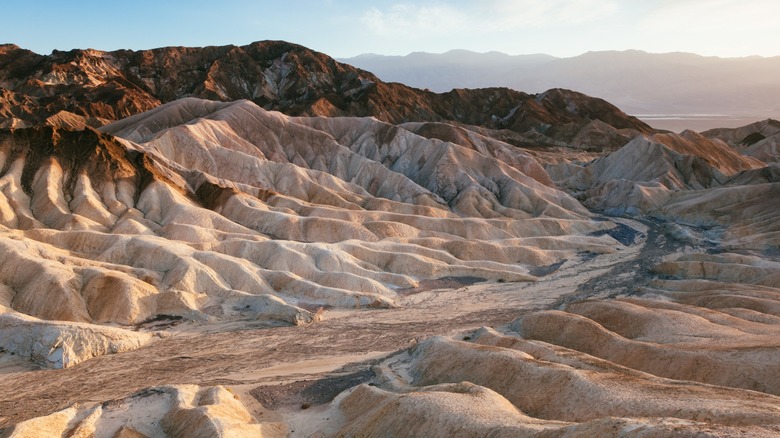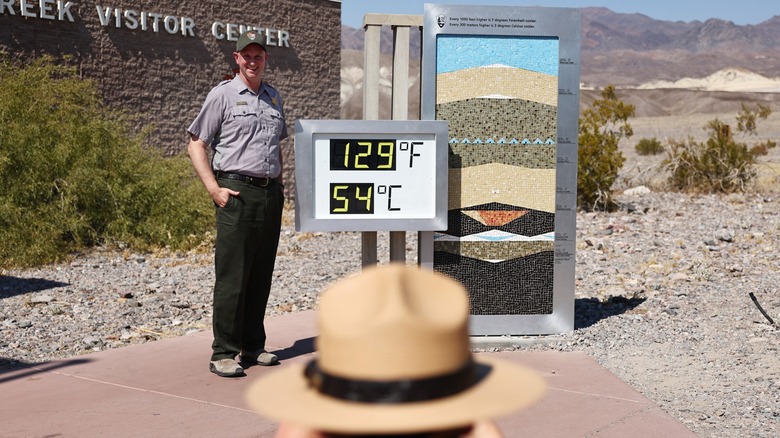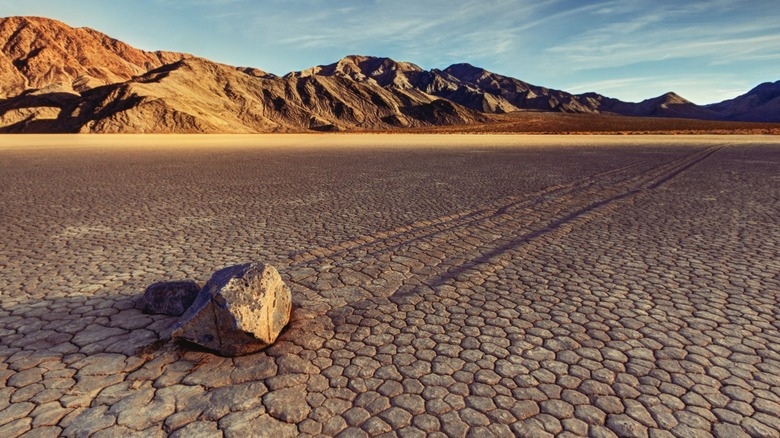Explore Surreal Mars-Like Landscapes At This Record-Breaking California National Park
If your ideal vacation means seeking out sandy dunes and heat waves so hot you can see the scorching temperature bending the air, take a trip to Death Valley National Park. The isolated place in southeastern California, two hours from Las Vegas, holds the record for hottest temperature on Earth at 134 degrees Fahrenheit. While the 1913 temperature reading has been questioned over the years, extreme heat in Death Valley is a scientific result of the area's unique geography. The valley is home to the lowest point in North America, 282 feet below sea level, and is walled in by steep mountains. Cloudy skies lose their moisture when traveling over the four mountain ranges between the Pacific Ocean and Death Valley, which means the perpetually clear skies trap heat in the basin; it ricochets off the rocks and soil, becoming a vacuum of hot air. Although Death Valley has never beat its 134 degree peak, the hottest summer days in July can often rise to 130 degrees.
If you are designing the perfect road trip itinerary to explore every national park in California, the hottest place on Earth is not to be missed. The ruptured desert peaks of Zabriskie Point and polygon formations on the Badwater Basin salt flats give travelers such eerie, otherworldly feelings. They may even come to question the moon landing when somewhere on the planet can look this strange. But it's also called Death Valley for a reason — so read on for some safety tips for your interstellar travel within this haunting zone of ungodly heat.
Choose your time and season to enter the park carefully
Death Valley National Park is open year-round and accessible from paved entrances at CA 190 and CA 178 in California, as well as SR 374 and SR 267 in Nevada. The Furnace Creek Visitor Center, at the end of Echo Canyon Road off CA 190, is a great place to start your journey. Visitors can buy a standard day pass, an annual pass if you expect to make return visits, or an America the Beautiful pass that gives access to all national parks. You can get the America the Beautiful pass for free by registering with your 4th grader.
The most popular time to visit is in the springtime, when colorful flowers burst through the desert beige in March and April. Once in a decade, a 'superbloom' of flowers following a particularly wet El Niño winter will enliven the desert; the last one as of this writing happened in 2016. Between the months of October and April, when temperatures reliably peak between 70 and 90 degrees Fahrenheit, you'll be able to hike, camp, mountain bike, and explore to your heart's content.
The desert planet of Tatooine, made famous in the original Star Wars trilogy, is just one of the exotic locations you can explore in a California national park that feels otherworldly; dark sky viewing in this remote and relatively unlit corner of the earth earns the Gold Tier classification by the International Dark-Sky Association. NASA scientists have often visited Death Valley to help test spacecraft in the inhospitable vastness of this almost-unlivable terrain.
Staying alive in Death Valley is a matter of preparation
Driving or hiking through back country roads, while popular with visitors awed by the valley's strange beauty, require care and planning. For one thing, many places in the park do not have cellular service or mobile data, leaving visitors isolated from help. The Furnace Creek Visitor Center, which has free public Wi-Fi, will be a lifeline for your exploration. Tap into a mobile connection, stock up on maps and extra water, and make a strategic plan, outlining your route and backup materials before you head into the 3.4 million acres of desolate backcountry.
If you are determined to not avoid this national park in the summer for your own safety, make sure you have at least one gallon of water per person in your vehicle, per day –- ideally more. Stay on paved roads, share your itinerary with a friend, and carry extra supplies for breakdowns in the car. Starting before 10 a.m. or after 4 p.m. is one of the best ways to avoid heat stroke while doing outdoor activities; indoors, the visitor's center and park museums can provide a backup plan. The National Park Service highly recommends avoiding lower elevation hiking, too. Instead, Telescope Peak –- the highest in Death Valley, at 11,049 feet –- will provide you with a strenuous hike at a slightly cooler temperature.


